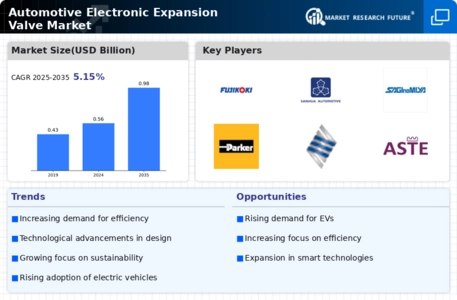Market Share
Automotive Electronic Expansion Valve Market Share Analysis
The Automotive Electronic Expansion Valve (EEV) market has seen distinct characteristics and development through the recent years. This is so that the automotive industry develops continuously. Alongside the tendency of vehicles to become more electronically advanced and as consumer requirements steer towards higher fuel efficiency and environmental sustainability, the demand for modern and intricate electronic components like EEV has experienced a significant boost.
A noticeable trend in the Automotive EEV market is the development of vehicles that are more energy-efficient and environmentally-friendly. Authorities throughout the globe are establishing strict laws in order to control emissions and encourage green policies in the automobile industry. This response has led to the automotive manufacturers using EEVs more and more to make the performance of the air conditioning and refrigeration systems in vehicles better. EEVs assist with precision regulation of refrigerant, resulting in increased efficiency of the whole system, and thus leading to minimizing energy consumption.
Also, the expansion of electric vehicles (EVs) is the key point in shaping the market trends. With increasing trend of electrification in automotive industry, the requirements for the electric vehicles have increased significantly. Thermal management is crucial for the electric vehicles because the performance and life span of their battery largely depends on it. While EEVs are the electronic devices forming an important component of these thermal management systems, by controlling the flow of refrigerant, they have an undeniable role in ensuring efficient cooling of batteries and other critical components.
The second important trend is the consideration of smart as well as connected technology for automotive EEVs. With technologies like the Internet of Things (IoT) and Industry 4.0 becoming more and more popular, there is an increasing tendency to develop connected vehicles that can communicate with external systems to share information in real-time. In the case of EFFs, this implies to the design and development of smart valves which can be remotely monitored and controlled. This connectivity does not only ensure that up-to-date data is available for proactive maintenance but also assists in the deployment of analytics for predictability to avert issues and make the system more efficient.
Moreover, significant developments related to sensor technologies have led to the remarkable transformation of the Automotive EEV market. The use of highly sensitive sensors makes it possible for the smart EVs to quickly react to changes of operating conditions and keep the refrigerant flow perfectly control. Such reactivity does not only increase the reliability and performance of whole system but it is adapted to the needs of modern automotive systems.
Further, the world automotive EEV industry is constantly undergoing R&D activities. Original equipment manufacturers (OEMs) are engaged in the continuous development of compact and efficient electronic valves to cater for the emerging needs of the auto sector.

















Leave a Comment